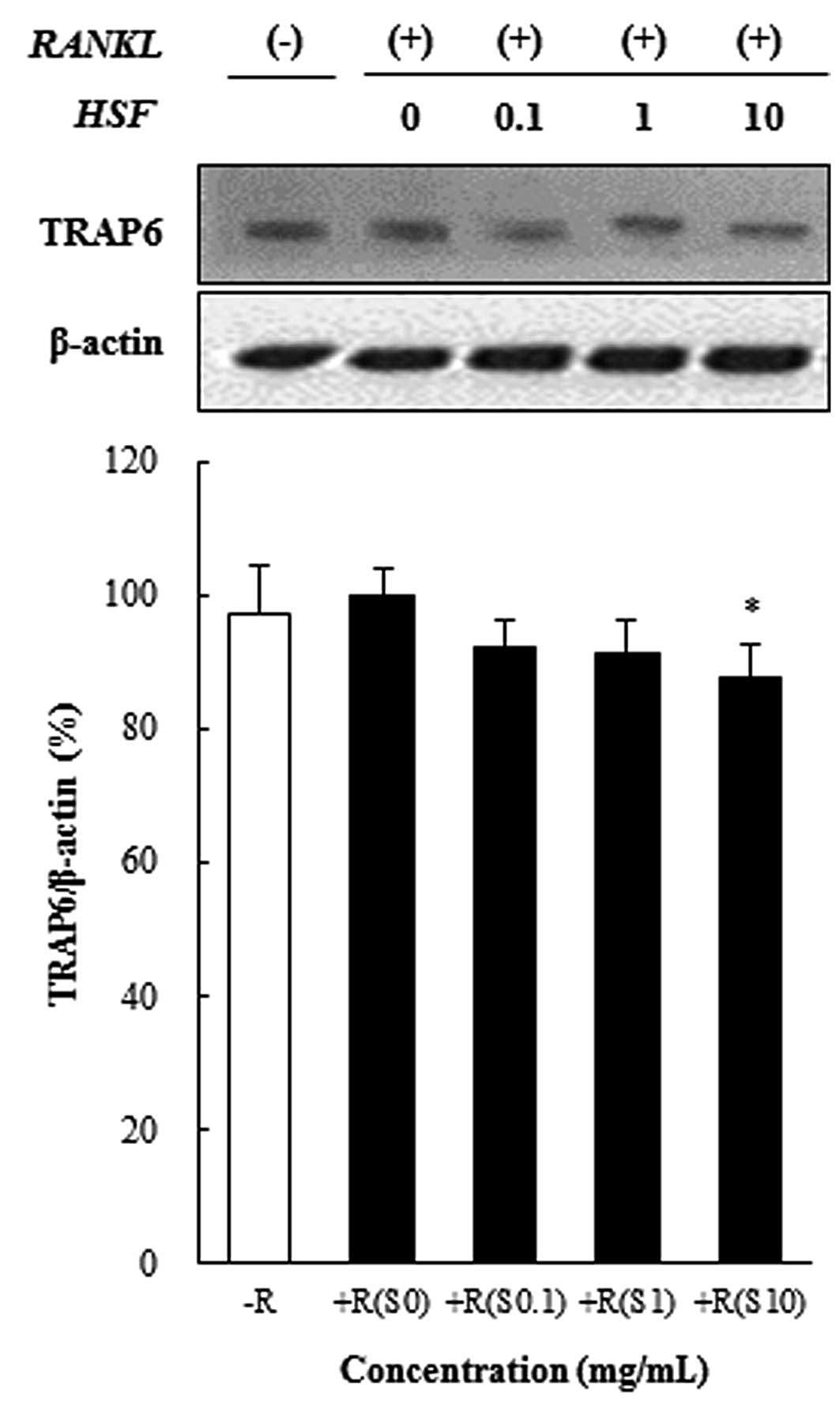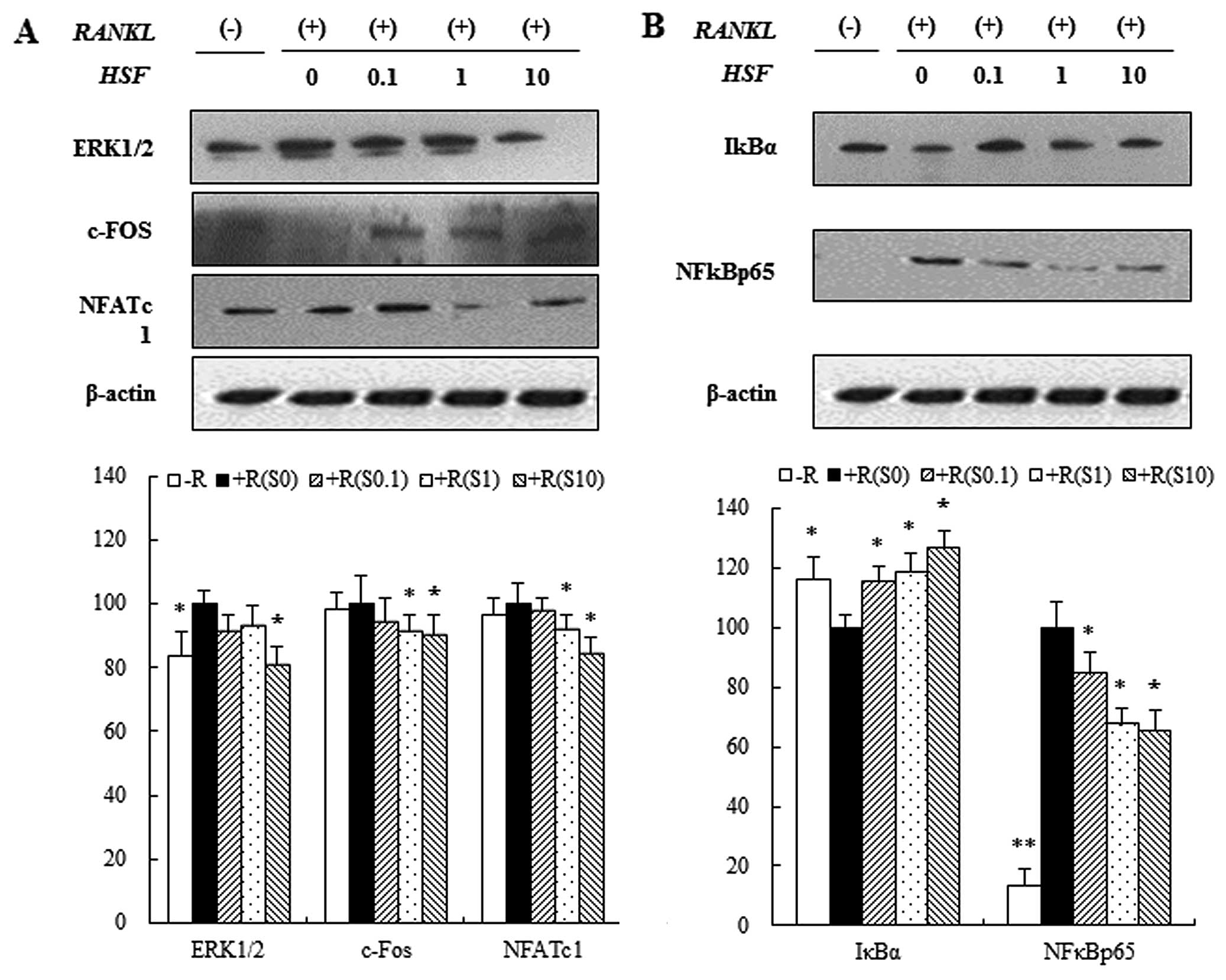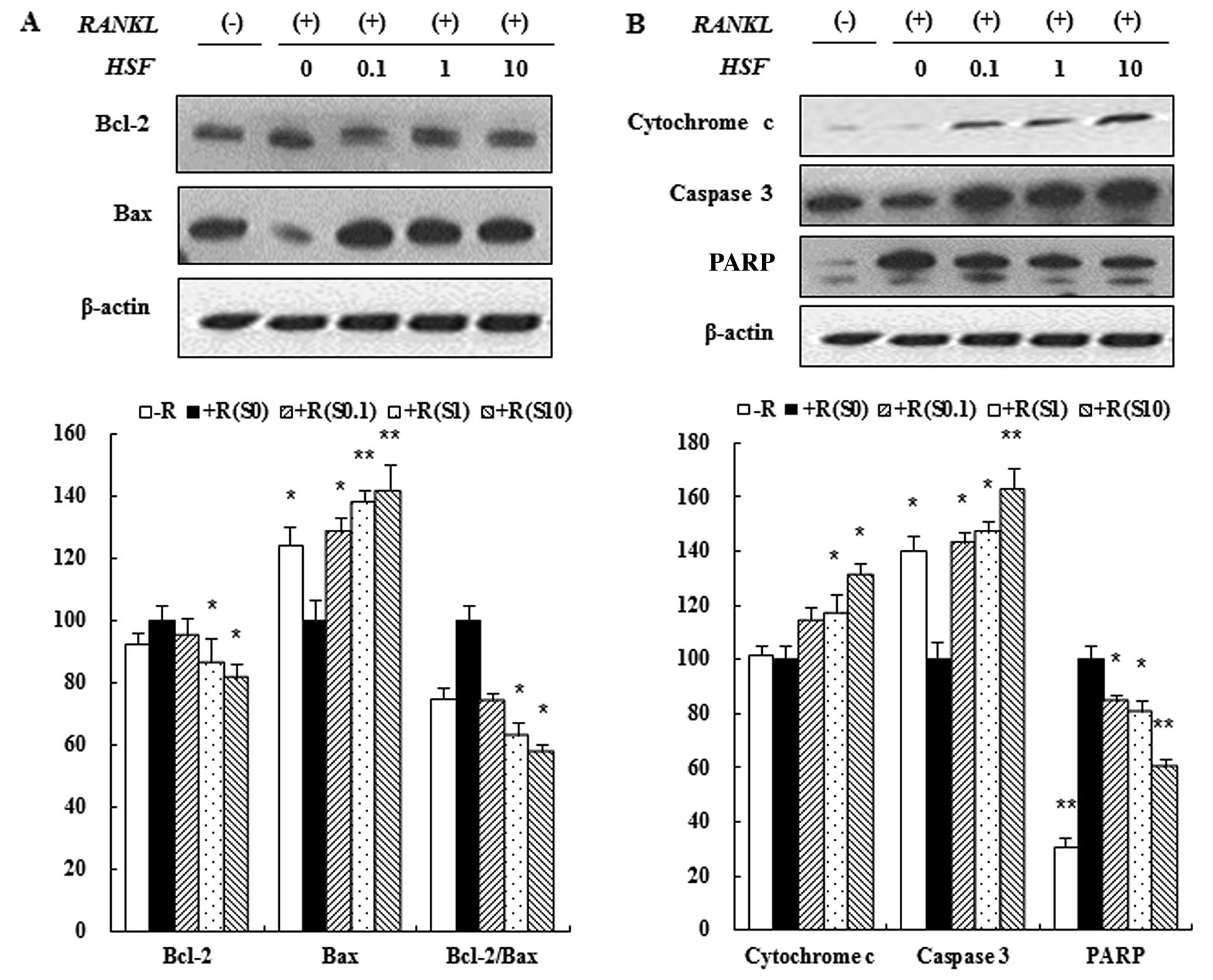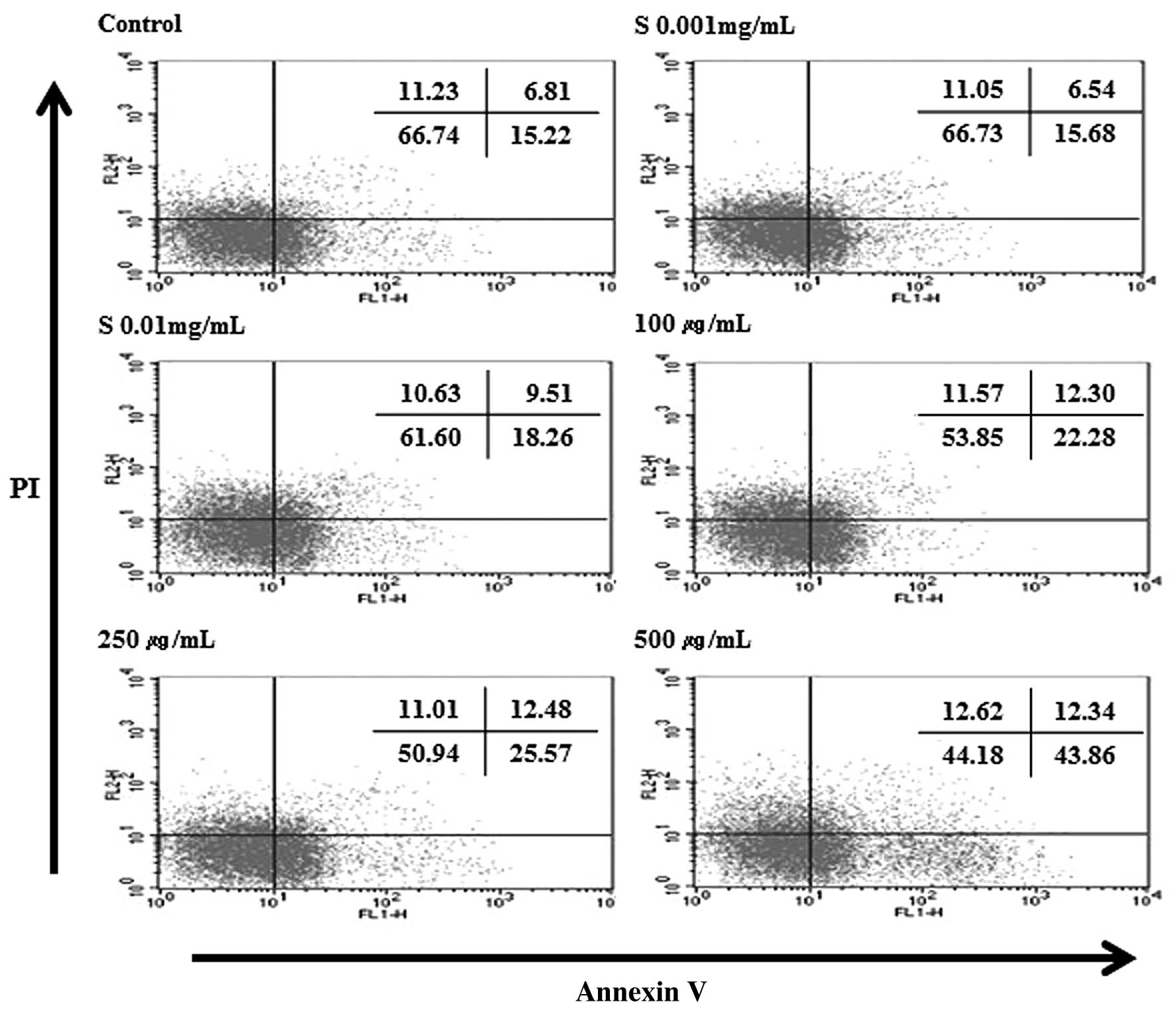Silk fibroin hydrolysate inhibits osteoclastogenesis and induces apoptosis of osteoclasts derived from RAW 264.7 cells
- Authors:
- Published online on: September 6, 2012 https://doi.org/10.3892/ijmm.2012.1120
- Pages: 1203-1210
Abstract
Introduction
Bone is continuously remodeled through bone formation by osteoblasts and bone resorption by osteoclasts. A balance of bone remodeling is important for maintaining skeletal strength and density (1). However, an imbalance in bone remodeling caused by excessive osteoclastic bone resorption leads to bone destructive diseases, such as osteoporosis (2).
Osteoclasts originate from hematopoietic precursor cells of the monocyte/macrophage series and differentiate into bone-resorbing multinucleated cells by fusion of mononuclear cells. The osteoclastic process consists of multiple steps, including osteoclastogenesis, activation, and apoptosis (3). Osteoclasts differentiate from preosteoclasts in the presence of receptor activator of nuclear factor-κB ligand (RANKL). Binding of RANKL to its receptor activates tumor necrosis factor receptor-associated factor 6 (TRAF6), which is induced through the activation of nuclear factor-κB (NF-κB) via the inhibitor of NF-κB (IκB) kinase and mitogen-activated protein kinases (MAPK) (4). In addition, activated extracellular signal-regulated kinase (ERK) can phosphorylate c-Fos, which subsequently phosphorylates the nuclear factor of activated T cells (NFATc) transcription factor (5). Therefore, RANKL induces transcription factors required for the regulation of genes involved in osteoclast differentiation. These osteoclasts are characterized by expression of the markers tartrate-resistant acid phosphatase (TRAP), matrix metalloproteinase-9 (MMP-9), cathepsin-K, and calcitonin receptor (CTR) (6).
Osteoclasts subsequently undergo apoptosis, which is programmed cell death characterized by cell chromatin condensation, cell shrinkage, and nuclear fragmentation (7). Osteoclast apoptosis is related to bone remodeling and the treatment of bone diseases (8). Osteoclasts possess general apoptotic mechanisms. The Fas receptor has been identified in mouse and human osteoclasts and in RAW 264.7 cells, and functions through a Fas signaling pathway (9) that is regulated by the Bcl-2 protein, which in turn controls the release of cytochrome c from mitochondria. Caspase proteins are activated via cytochrome c, and apoptosis is typically defined by activated caspase-3 (10). The relative rate of pro-apoptotic and anti-apoptotic events determines susceptibility to death signals.
In recent years natural compounds that inhibit bone resorption have been studied for their ability to reduce the rate of osteoclast differentiation or the number of activated osteoclasts, or to induce osteoclast apoptosis. Among these, agents that inhibit osteoclast differentiation have been proposed to prevent and treat osteoporosis (11). Prior studies associated with inhibition of osteoclastogenesis can be divided into two groups. It was reported that osteoclasts interact closely with osteoblasts. RANKL, a member of the TNF family, is a significant factor in osteoclast differentiation. RANKL is expressed by osteoblasts/stromal cells, and its expression is increased by factors including 1,25(OH)2D3, prostaglandinE2 (PGE2), parathyroid hormone (PTH), and interleukin-11 (IL-11). Osteoprotegein (OPG) is a decoy receptor for RANKL that negatively regulates bone resorption by binding to RANKL. Thus, in many environments, osteoclastogenesis is regulated indirectly by osteoblasts/stromal cells (12). Therefore, natural extracts such as soybean and Scutellaria radix used in the treatment of osteoblasts have indirect inhibitory effects on osteoclastogenesis. An alternative method for demonstrating direct effects on the inhibition of osteoclastogenesis is through blockage of signaling pathways induced by RANKL in RAW 264.7 cells (13,14).
Silk is a well known fibrous protein produced by the silkworm that has been used traditionally as textile fibers and surgical sutures for humans (15). It is composed of two kinds of proteins, a filament core protein (fibroin) and a gum-like coating protein (sericin) that surrounds the fibroin fibers to cement them together. Silk fibroin consists of heavy and light chain polypeptides of ∼390 and ∼25 kDa, respectively, linked by a disulfide bond at the C-termini of the two subunits through hydrophobic interactions. The hydrophobic blocks tend to form β-structures or crystals through hydrogen bonding and hydrophobic interactions, forming the basis for the tensile strength of silk fibroin (16). Hydrolysates of silk fibroin are water-soluble peptides that have been investigated as food and dietary supplements. Hydrolysate silk fibroin contains 18 kinds of amino acids including Gly (45.9%), Ala (30.3%), Ser (12.1%), Tyr (5.3%) and Val (1.8%) (17,18). Numerous studies have documented a range of effects of hydrolysate silk fibroin, including moisturizing (19), wrinkle improvement, inhibition of tyrosinase (20), and apoptosis (21), and biomedical applications such as a matrix for mammalian cell culture and enzyme immobilization (22), a scaffold for bone substitution (23), a wound dressing (24), and a drug delivery carrier (25). Silk fibroin hydrolysate has also been used in biomedical materials, such as bone, cartilage, and ligaments (26). In a previous study, we demonstrated the indirect effect of silk fibroin on the inhibition of osteoclastogenesis in RAW 264.7 cells (27). These results led us to investigate the direct effect of hydrolysate silk fibroin on osteoclastogenesis.
Therefore, in this study we investigated the effect of hydrolysate silk fibroin on signaling pathways involving ERK1/2 and NF-κB and the induction of apoptosis. Mouse RAW 264.7 cells were grown to fully differentiate into osteoclasts and expression levels of genes such as MMP-9, TRAP, cathepsin-K and CTR, which are well known markers for osteoclasts, were also measured.
Materials and methods
Preparation of extract from silk fibroin
Raw silk (Bombyx mori L.) cocoons reared on a farm affiliated with the Rural Development Administration of Korea were used as the raw materials. The raw materials were degummed twice with 0.5% on the weight of fiber (OWF) Marseilles soap and a 0.3% OWF sodium carbonate solution at 100°C for 1 h and then washed with distilled water. Degummed silk fibroin fibers were dissolved in a mixed solution of CaCl2, H2O, and ethanol at 95°C for 5 h. This calcium chloride/silk fibroin mixed solution was filtered twice through a Miracloth (Calbiochem, San Diego, CA, USA) quick filter. For the desalting of the calcium chloride/silk fibroin mixed solution, gel filtration column chromatography was performed on a GradiFrac system (Amersham Parmacia Biotech, Tokyo, Japan) equipped with a UV-1 detector operating at 210 nm. A commercially available and prepacked Sephadex G-25 column (800 × 40 mm i.d. Amersham Parmacia Biotech) was used. Distilled water was used as the elution solvent at a flow rate of 25 ml/min; the sample injection volume was 200 ml, and the fraction volume was 30 ml.
Enzymatic hydrolysis and fractionation
A proteolytic enzyme, actinase from Streptomyces griseus (Kaken Chem Co., Tokyo, Japan), was used for enzymatic degradation. The silk fibroin solution and 5% actinase with respect to the weight of the fibroin were mixed under nitrogen gas at 55°C for 12 h. Then, the solution was heated in a boling water bath to stop the enzyme reaction and centrifuged at 5,000 rpm for 10 min. Recycling HPLC was performed to fractionate the enzyme-hydrolyzed silk fibroin on a JAI-908-C60 HPLC apparatus (Japan Analytical Industry Co., Tokyo, Japan) equipped with a JAI refractive-index and UV detectors operating at 220 nm. Both a commercially available and prepacked PVA HP-GPC column (JAI-GEL GS-220, 100 cm × 5 cm i.d.) and an ODS-BP column (JAI-GEL, 100 cm × 5 cm i.d.) were employed. Water was used as the eluting solvent at a flow rate of 3 ml/min; the sample injection volume was 20 ml. The hydrolysate silk fibroin was concentrated and stored at −20°C until use.
Cell culture and induction of osteoclast differentiation
Mouse monocyte/macrophage RAW 264.7 cells were purchased from the American Type Culture Collection (ATCC, Manassas, VA, USA) and maintained in DMEM supplemented with 10% FBS and 1% antibiotics in a humidified atmosphere of 5% CO2 at 37°C, with a media change every three days. In order to induce differentiation into osteoclasts, RAW 264.7 cells were resuspended in DMEM supplemented with 10% FBS and 50 ng/ml RANKL (Petrotech Inc., Seoul, Korea) and plated in a 24-well plate. Multinucleated osteoclasts were observed starting on differentiation Day 3.
Cell viability assay
RAW 264.7 cells were treated with varying doses (0.001, 0.01, 0.1, 1 and 10 mg/ml) of hydrolysate silk fibroin for 24, 48 and 72 h. After treatment, the cells were incubated with the MTT solution for 3 h at 37°C. The supernatants were carefully aspirated, 200 μl DMSO was added to each well, and the plates were agitated to dissolve the crystal product. Absorbance was measured at 570 nm using the VersaMax multi-well plate reader (Molecular Devices Corp., Sunnyvale, CA, USA).
Western blot analysis
RAW 264.7 cells were washed twice with ice-cold PBS and lysed with extraction buffer containing 20 mM Tris, pH 8, 150 mM NaCl, 10 mM sodium phosphate, 100 μM sodium vanadate, 100 μM ammonium molybdate, 10% glycerol, 0.1% Nonidet P-40, 0.1% SDS, and 1X protease and phosphatase inhibitors. Insoluble materials were removed by centrifugation at 12,000 rpm for 20 min. The total concentration of extracted proteins was determined using the Bradford method (28). The proteins in the supernatants (25 μg/lane) were electrophoretically separated on SDS-polyacrylamide gels (10–12% SDS-PAGE) and transferred to nitrocellulose membranes. Blots were blocked in 5% skim milk diluted in PBS-T buffer (PBS containing 0.5% Tween-20) for 1 h and then incubated overnight with polyclonal antibodies against TRAF6, Erk1/2, C-Fos, NFATc1, IκBα, NF-κB, MMP-9, CTR, cathepsin-K, poly ADP-ribose polymerase (PARP), cytochrome c, Bcl-2, Bax, caspase-3, and β-actin (Cell Signaling Technology, Beverly, MA, USA). To detect the antigen-bound antibody, the blots were treated with secondary antibody conjugated with horseradish peroxidase (HRP) coupled anti-IgG. Immunoreactive proteins were visualized by an enhanced chemiluminescence (ECL) detection system, and band intensity was quantified by densitometry (Biomaging systems ver.4.8, UVP Inc., San Gabriel, CA, USA).
Annexin V/propidium iodide (PI) flow cytometric analysis
Phosphatidylserine exposed on the outside of apoptotic cells was determined by an Annexin V-fluorescein isothiocyanate (FITC) apoptosis kit (Roche Molecular Diagnostics, Mannheim, Germany). To detect apoptosis and necrosis induced by silk fibroin in RAW 264.7 cells, the cells were treated with different concentrations of hydrolysate silk fibroin (0.001, 0.01, 0.1, 1 and 10 mg/ml) for 72 h. After treatment the cells were harvested, washed twice with ice-cold PBS, and centrifuged. The cells were then stained with 100 μl Annexin V-FITC labeling solution supplemented with 20 μl Annexin V-FITC labeling reagent, 20 μl PI solution, and 1 ml incubation buffer at room temperature for 15 min in the dark. Annexin V-FITC and PI emissions were detected in the FL1 and FL2 channels of a FACScan flow cytometer (BD Biosciences, San Jose, CA, USA) using emission filters of 525 and 575 nm, respectively. The percentage distribution of intact (Annexin V-FITC−/PI−), early apoptotic (Annexin V-FITC+/PI−), late apoptotic (Annexin V-FITC+/PI+), and necrotic cells (Annexin V-FITC−/PI+) was calculated using the CellQuest™ software (BD Biosciences).
Statistical analysis
Each experiment was performed in triplicate and the results are expressed as the mean ± SD. Statistical analysis was performed using the SPSS software. Analysis of variance was performed using ANOVA procedures. Significant differences (P<0.05) between the means were determined by the Duncan's multiple range tests.
Results
Effect of hydrolysate silk fibroin on RAW 264.7 cell viability
In order to measure the cytotoxic effect of hydrolysate silk fibroin on the murine monocyte/macrophage cell line RAW 264.7, we treated cells with different concentrations of hydrolysate silk fibroin for 24, 48 and 72 h and measured cell viability using the MTT assay. As shown in Fig. 1, hydrolysate silk fibroin significantly reduced the viability of RAW 264.7 cells in a dose- and time-dependent manner. However, the extent of inhibition did not exceed 50%.
Hydrolysate silk fibroin inhibits osteoclast differentiation in RAW 264.7 cells
To investigate the effect of hydrolysate silk fibroin on osteoclastogenesis of RAW 264.7 cells, cells were grown in the presence of RANKL (50 ng/ml) to induce the activation of TRAF6 through the binding of RANKL to RANK. Activated TRAF6 is known to induce the expression of c-Fos, NFATc1, and NF-κB, which are essential for osteoclastogenesis. Hydrolysate silk fibroin significantly inhibited the RANKL-induced activation of TRAF6 in preosteoclasts, as shown in Fig. 2.
Effects of hydrolysate silk fibroin on the ERK signaling pathway, NF-κBp65 subunit, and IκB in RAW 264.7 cells
Three mitogen-activated protein kinases (p38, ERK and JNK) have been implicated in the mediation of RANKL-regulated osteoclastogenesis (29). To investigate the signaling pathways by which hydrolysate silk fibroin inhibits osteoclastogenesis, we evaluated the effect of hydrolysate silk fibroin on the signaling pathways of ERK and NF-κB. Through the ERK1/2 signaling pathway, RANKL (50 ng/ml) induced the expression of ERK1/2 in RAW 264.7 cells. This expression of ERK1/2 was attenuated by hydrolysate silk fibroin. Since activated ERK1/2 induces expression of c-Fos and NFATc1 proteins, which are essential for osteoclastogenesis, we examined the effects of hydrolysate silk fibroin on the expression of c-Fos and NFATc1. RANKL induced the expression of c-Fos and NFATc1, but treatment with hydrolysate silk fibroin significantly inhibited RANKL-induced c-Fos and NFATc1 expression (Fig. 3A). Activation of NF-κB is also involved in osteoclastogenesis (30). NF-κB, a key transcription factor for osteoclastogenesis, is activated via the IκB kinase signaling pathway (12) and translocation of the NF-κBp65 subunit into the nucleus is induced by RANKL. Our data showed that hydrolysate silk fibroin inhibited NF-κBp65 expression and degradation of IκBα in a dose-dependent manner (Fig. 3B).
Hydrolysate silk fibroin inhibited expression of osteoclast-specific proteins
Osteoclastogenesis is associated with upregulation of specific proteins in response to RANKL (31). Therefore, we assessed the inhibitory effect of hydrolysate silk fibroin on osteoclastogenesis by evaluating the expression of osteoclast-related proteins such as MMP-9, cathepsin-K and CTR. Immunoblot analysis showed that the expression of osteoclastic protein markers was increased by RANKL, but treatment with hydrolysate silk fibroin inhibited expression of these proteins in a dose-dependent manner (Fig. 4). These results indicate that hydrolysate silk fibroin has a specific effect on the regulation of proteins that are induced during osteoclastogenesis.
Hydrolysate silk fibroin induced apoptosis of osteoclasts
Apoptosis is characterized by activation of a caspase cascade that can be induced by the release of cytochrome c. We evaluated the effect of hydrolysate silk fibroin on caspase-3 activation and cytochrome c release in osteoclasts. RAW 264.7 cells were incubated in the absence or presence of RANKL with hydrolysate silk fibroin (0.1, 1 and 10 mg/ml) for 72 h. Proteins were analyzed by immunoblotting and quantified by densitometric analysis. Caspase-3 activity was induced by hydrolysate silk fibroin at high concentrations (10 mg/ml) (Fig. 5B). Additionally, the release of cytochrome c into the cytoplasm was increased by hydrolysate silk fibroin in a dose-dependent manner (Fig. 5B). Hydrolysate silk fibroin induced the cleavage/activation of caspase-3 and PARP, and decreased the expression of anti-apoptotic proteins such as Bcl-2 in a dose-dependent manner. In contrast, expression of Bax was increased by Hydrolysate silk fibroin in a dose-dependent manner (Fig. 5A).
Hydrolysate silk fibroin induces apoptosis in RAW 264.7 cells by Annexin V/PI analysis
To ascertain the mechanism of cell death (apoptosis or necrosis), RAW 264.7 cells were treated with different concentrations of hydrolysate silk fibroin (0.001, 0.01, 0.1, 1 and 10 mg/ml) for 72 h, and then stained with Annexin V-FITC and PI. This protocol is based on the observation that, soon after initiating apoptosis, membrane phosphatidylserine (PS) translocates from the inner face of the plasma membrane to the cell surface where it can be easily detected by staining with a fluorescent conjugate of Annexin V, a protein that has a very strong affinity for PS. Simultaneous staining with Annexin V-FITC and PI non-vital dye makes it possible to distinguish between intact, early apoptotic, late apoptotic, and necrotic cells. The results indicated that hydrolysate silk fibroin decreased the percentage of live cells and increased the number of early apoptotic cells. When the concentrations increased, the percentage of normal cells decreased from 65.01% (control) to 48.75% (10 mg/ml). However the percentage of apoptotic cells increased from 25.17% (control) to 39.96% (10 mg/ml) (Fig. 6). These results indicate that the decrease in live cells is due at least in part to the effect of hydrolysate silk fibroin on inducing apoptosis.
Discussion
There is growing interest about the use of natural extracts to prevent loss of bone mass by inhibiting osteoclastogenesis and bone resorptive activity, and/or inducing osteoclast apoptosis. Silk fibroin possesses several biological and pharmacological activities including reducing cholesterol, hypoglycemia, and growth of osteoblasts, and enhancing bone formation (32). A previous study reported that silk fibroin inhibits osteoclastogenesis. This study further demonstrated that osteoclastogenesis is indirectly inhibited by osteoblasts/stromal cells; however, there are no studies showing direct inhibition of osteoclastogenesis.
Therefore, the aims of this study were to evaluate the effects of hydrolysate silk fibroin on osteoclastogenesis and the induction of apoptosis. We found that hydrolysate silk fibroin is a potent inhibitor of osteoclasts in RANKL-stimulated RAW 264.7 cells. As shown in Fig. 3, the inhibitory effect of hydrolysate silk fibroin was demonstrated by measuring the RANKL-induced expression of osteoclast-related proteins such as MMP-9, cathepsin-K, and CTR, which are required for the bone resorptive activity of mature osteoclasts. MMP-9 and cathepsin-K are highly expressed in osteoclasts. MMP-9 can initiate the osteoclastic resorption process by removing the collagenous layer from the bone surface (33), while cathepsin-K plays an essential role in osteoclastic bone resorption (34,35). Therefore, these results suggest that hydrolysate silk fibroin could inhibit the resorbing capacity of osteoclasts.
The effects of hydrolysate silk fibroin on the signaling mechanism of RANKL were clearly demonstrated. The inhibitory effect of hydrolysate silk fibroin on the differentiation stage results from suppression of RANKL-induced ERK1/2 signaling and expression of NF-κBp65. Binding of RANKL to RANK stimulates TRAF6 and various transcription factors (36). TRAF6 activation subsequently leads to the activation of MAP kinases (ERK, JNK and p38) and NF-κB, which induces the expression of proteins required for osteoclastogenesis (37). Several transcription factors have been suggested to regulate induction of genes involved in RANKL-induced osteoclastogenesis (38). Importantly, RANKL specifically and strongly induces NFATc1, the master regulator of osteoclastogenesis, and this induction is dependent on c-Fos pathways (39). RANKL has been shown to elevate the level of c-Fos expression in osteoclasts, and our data indicated that hydrolysate silk fibroin inhibits this RANKL-induced c-Fos expression (Fig. 4A). We therefore investigated whether hydrolysate silk fibroin reduced the activation of NFATc1 in osteoclastogenesis in RAW 264.7 cells. As shown in Fig. 4A, hydrolysate silk fibroin reduced the transcriptional activity of NFATc1. These results suggest that hydrolysate silk fibroin suppressed NTATc1 by inhibiting the upregulation of c-Fos in response to RANKL. When RANKL-stimulated RAW 264.7 cells were treated with hydrolysate silk fibroin, MMP-9 expression was inhibited in a response similar to that of NFATc1 expression. NFATc1 was proposed to act as a downstream mediator of increased MMP-9 expression during osteoclastogenesis (40). Therefore, our results suggest that the inhibitory effect of hydrolysate silk fibroin on MMP-9 may be responsible for the downregulation of NFATc1 activation.
As mentioned above, NF-κB is another transcription factor that is activated by the RANKL signaling pathway in osteoclastogenesis. In the absence of RANKL, NF-κB is retained in the cytoplasm as a complex with the IκB protein. However, when the cells are stimulated by RANKL, the IκB kinase (IKK) complex phosphorylates IκB and the phosphorylated IκB is targeted by the proteasome and subsequently degraded, leading to the activation of NF-κB signaling. The NF-κBp65 subunit is separated from IκBα and enters the nucleus where it enhances transcription of target genes (41). Therefore, inhibition of NF-κB translocation might be an effective approach to target osteoclastogenesis. In our study, hydrolysate silk fibroin inhibited RANKL-induced IκB degradation and activation of NF-κBp65 in the cytoplasm. These findings raise the possibility that silk fibroin prevents the translocation of the NF-κBp65 subunit through the blockade of phosphorylation-induced IκBα degradation.
In addition to its effects on osteoclastogenesis, hydrolysate silk fibroin also induced apoptosis in osteoclasts. Osteoclasts are characterized by multinuclearity, an actin ring structure, and acidic cell conditions during resorption. Osteoclasts can be inhibited by disrupting the actin ring, triggering their apoptosis, and/or inhibiting expression/activity of proteins required for their function (42). The classical Fas signaling pathway involving mitochondrial release of cytochrome c and activation of caspase-3 has been identified in mouse and human osteoclasts and in RAW 264.7 cells (9). Therefore, we investigated the effect of hydrolysate silk fibroin on the activation/expression of apoptotic signaling molecules in osteoclasts by immunoblot analysis of RAW 264.7 cells. As shown in Fig. 5, the Fas signaling pathway was induced by hydrolysate silk fibroin. In addition, anti-apoptotic Bcl-2 was downregulated and pro-apoptotic Bax was upregulated by treatment with hydrolysate silk fibroin. These results suggest that hydrolysate silk fibroin has antiresorptive activity by both inhibiting osteoclastogenesis and inducing apoptosis of osteoclasts. Although our findings are preliminary and have certain limitations, our study may provide new insight toward understanding the mechanisms of osteoclastogenesis and apoptosis.
In conclusion, we suggest that hydrolysate silk fibroin modulates expression of specific genes in osteoclasts through downregulation of transcription factors such as NFATc1 and NF-κB, and also induces apoptosis of osteoclasts. Therefore, hydrolysate silk fibroin may be a useful natural compound for reducing osteoclastogenesis and preventing bone resorption.
Acknowledgements
This study was supported by 2012 Post-doctoral Fellowship Program (PJ906973022012) of National Academy Science, Rural Development Administration, Republic of Korea.















